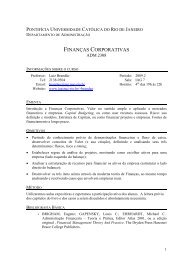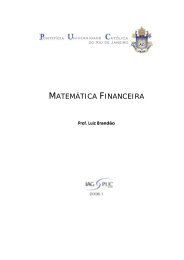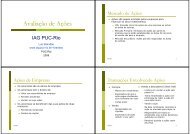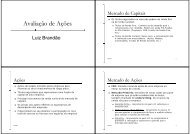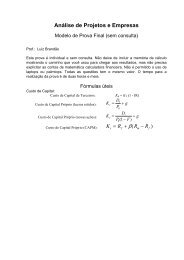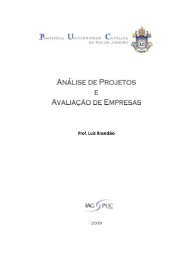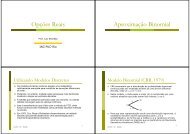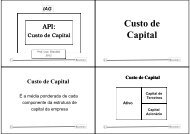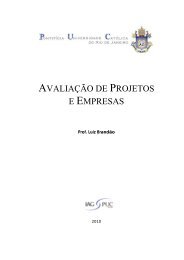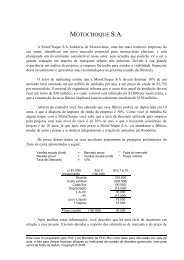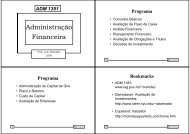Teoria dos Jogos - IAG - A Escola de Negócios da PUC-Rio
Teoria dos Jogos - IAG - A Escola de Negócios da PUC-Rio
Teoria dos Jogos - IAG - A Escola de Negócios da PUC-Rio
Create successful ePaper yourself
Turn your PDF publications into a flip-book with our unique Google optimized e-Paper software.
Duopólio em Quanti<strong>da</strong><strong>de</strong>s <strong>de</strong> Cournot<br />
No problema <strong>da</strong> escolha ótima <strong>de</strong> quanti<strong>da</strong><strong>de</strong> q i , a(s)<br />
firma(s) resolvem problemas <strong>de</strong> maximização <strong>de</strong> lucro π i .<br />
Para maximizar o lucro usa-se a condição <strong>de</strong> 1ª or<strong>de</strong>m<br />
(CPO): ∂π i /∂q i = 0 (checar a <strong>de</strong> 2ª or<strong>de</strong>m: ∂ 2 π i /∂q i2 < 0).<br />
No caso do duopólio, o equilíbrio <strong>de</strong> Nash-Cournot é<br />
obtido com ambas as firmas escolhendo as quanti<strong>da</strong><strong>de</strong>s<br />
que maximizam o lucro, consi<strong>de</strong>rando no problema <strong>de</strong><br />
otimização que a firma rival estará fazendo o mesmo.<br />
Pois o EN é a melhor resposta simultânea (não há incentivo<br />
para nenhum jogador <strong>de</strong>sviar se estiver sendo jogado o EN) e é<br />
assumido conhecimento comum (a firma sabe que a outra ...).<br />
Melhor resposta simultânea: curvas <strong>de</strong> melhor resposta se cruzam.<br />
Se o custo operacional (fixo + variável) <strong>de</strong> ca<strong>da</strong> firma é<br />
C i (q i ) e a função <strong>de</strong>man<strong>da</strong> é p(Q T ), as funções lucros são:<br />
π 1 = q 1 p(Q T ) − C 1 (q 1 ) e π 2 = q 2 p(Q T ) − C 2 (q 2 )<br />
Duopólio em Equilíbrio <strong>de</strong> Nash-Cournot<br />
Seja uma curva inversa <strong>de</strong> <strong>de</strong>man<strong>da</strong> linear (por ser mais<br />
simples, é a mais usa<strong>da</strong>), on<strong>de</strong> os preços são <strong>da</strong><strong>dos</strong> por:<br />
p(Q T<br />
) = a − b Q T<br />
⇒ p(Q T<br />
) = a − b (q 1<br />
+ q 2<br />
) ,<br />
com q 1 ≥ 0 ; q 2 ≥ 0 ; e a e b tal que p > 0<br />
Se o custo fixo é zero, a função lucro <strong>da</strong> firma i (1 ou 2) é:<br />
π i = q i a − q i b (q 1 + q 2 ) − c i q i = q i (a − c i ) − q i b (q 1 + q 2 )<br />
On<strong>de</strong> c i é chamado <strong>de</strong> custo operacional variável <strong>da</strong> firma i.<br />
A curva <strong>de</strong> reação ou curva <strong>de</strong> melhor resposta <strong>da</strong> firma i<br />
(i = 1; 2) em relação a produção <strong>da</strong> firma j (j ≠ i), q i *(q j ),<br />
é obti<strong>da</strong> com a condição <strong>de</strong> 1ª or<strong>de</strong>m (CPO).<br />
A interseção <strong>da</strong>s duas curvas <strong>de</strong> reação, q 1<br />
*(q 2<br />
) e q 2<br />
*(q 1<br />
),<br />
é o ponto <strong>de</strong> melhor resposta simultânea ⇒ éEN!<br />
Para tal, basta substituir a curva <strong>de</strong> melhor resposta <strong>de</strong><br />
uma na <strong>da</strong> outra, isto é, obter q 1<br />
*(q 2<br />
*) e q 2<br />
*(q 1<br />
*). O par<br />
{q 1<br />
*(q 2<br />
*); q 2<br />
*(q 1<br />
*)} é EN (próx. sli<strong>de</strong>):<br />
18



